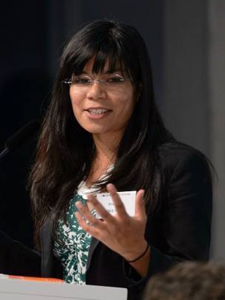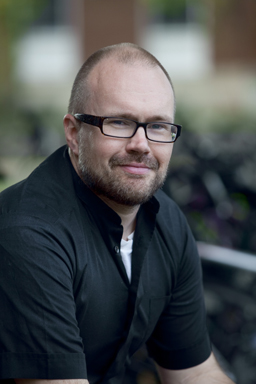Professors Comment on Implications of Trump’s Paris Accord Withdrawal
By Rebecca Goldfine
Laura Henry, the John F. and Dorothy H. Magee Associate Professor in Government And Legal Studies, researches social movements, particularly environmental movements, and the politics of Russia and the post-Soviet republics.
It is possible to argue that President Trump’s decision to withdraw the United States from the Paris climate accord is not a significant act because: 1) the president had already ended many of Obama’s Clean Power programs that were designed to fulfill the country’s commitments under the Paris agreement; 2) many of the 50 states, US cities, and other institutions will continue with their owns plans to reduce greenhouse gas emissions; and 3) the US cannot technically withdraw from the agreement until November 2020 so the next president can overturn the decision.
Nevertheless, US withdrawal is a serious blow to global climate politics and to US leadership more broadly. First, the Paris climate accord was designed to provide maximum flexibility to each participating state in determining the most cost effective way to lower emissions (so called INDCs, or intended nationally determined contributions). Ideally, states would maintain their INDC commitments due to peer pressure and careful monitoring. These commitments could be ratcheted upward overtime. By disregarding an accord based on voluntary emissions cuts, President Trump chose to forego the opportunity to revise US commitments and instead took a hard exit – in effect, rejecting the entire enterprise of a global climate agreement rather than just rethinking the US role. US withdrawal substantially undermines the pressure for other states to act; in addition, the US no longer has a seat at the table and can no longer press for robust monitoring of other states’ behavior or influence the evolution of the agreement. Also, despite bearing historical responsibility for a significant portion of the greenhouse gases currently in the atmosphere, US withdrawal means that we will not continue to meet our pledge to the Green Climate Fund to help developing countries adapt to climate change. Given the virtual impossibility of negotiating a more flexible international climate agreement, there is little chance of the US federal government re-engaging in global climate politics during the next three and a half years. State and municipal officials, corporate leaders, and citizens may continue to act. Indeed, following President Trump’s decision, President Macron of France invited US-based climate scientists to work in France, the Canadian government recommitted to working directly with US states on climate issues, and Hawaii became the first state to commit itself directly to the Paris climate accord.
Perhaps more important is the broader message that US withdrawal sends to other states – that the US no longer wants to take a leading role in international affairs. As many commentators have noted, the US decision to withdraw from the Paris accord provides space for the European Union and China to steer international climate politics in the future and to seize economic opportunities created by the development of low carbon economies. EU officials vowed to work with US states and US-based corporations to continue to address climate change. EU President Donald Tusk and Chinese Prime Minister Li Keqiang held a joint press conference during which they restated their commitment to help poorer countries address climate change. This shift in authority on the international stage runs parallel to the president’s recent decisions to question long-standing trade agreements and security alliances. Even as President Trump questions the architecture of global governance, the US cannot protect itself from global political and economic stability in the future. US failure to act today to help regions vulnerable to climate change does not insulate the country from future conflicts and refugee flows. Indeed, far from “laughing at us,” other states have counted on the United States to use its credibility and capacity to address the global collective action problems, climate change and beyond.
Visiting Assistant Professor of Government and Environmental Studies Divya Gupta’s research encompasses environment and development discourses, especially in connection to community-based natural resource management.

The fact that the US rejected a climate agreement that it played a central role in negotiating is unfortunate to say the least. One would imagine that being the second largest greenhouse gas emitter, the US’s exit from the agreement will make meeting the globally negotiated “two degrees temperature limit” target much harder. But the reality as we all are currently witnessing is completely different. The departure of the US from the Paris agreement, instead of quashing peoples’ hopes has in fact rekindled and reinvigorated efforts to combat climate change. There is proliferation of new actors, emergence of new leaders, and formation of new alliances — all upholding the sentiments of the Paris accord and buttressing their commitment to fight climate change.
Within the US, at the sub-national level — states, cities and businesses are ramping up efforts. Just hours after President Trump announced that he intended to withdraw US from the Paris climate agreement, the governors of California, Washington and New York announced formation of the United States Climate Alliance — a union that will work to reduce greenhouse gas emissions and uphold the goals and standards of Paris agreement regardless of any federal support. The governor of Hawaii recently signed legislation that commits the state to reducing their emissions to align with the goals of Paris agreement. In addition, more than 1,200 business leaders, mayors, governors and college presidents have also expressed their personal commitment of reducing emissions. In an open letter, the signatories vowed to “continue to support to meet the Paris agreement even in the absence of leadership from Washington.”
At the international level, the lingering threat of the US withdrawal over these past months has cemented new alliances and fostered a stronger sense of solidarity among other nations. For example, the European Union and China have reportedly planned an alliance to lead implementation of the Paris agreement. The BASIC (Brazil, South Africa, India and China) countries also reiterated their “unwavering commitment” to the Paris agreement. These new geopolitical interactions in my view are likely to provide a greater impetus for climate action and will possibly kickstart more innovations, thereby proving, as noted by the world leaders during Marrakech Conference (COP22), that momentum on climate action in the future will be irreversible.
President Trump’s action to exit from the Paris agreement is undoubtedly a huge shock and has left a gaping hole in the established regime for global climate action. But this void has in turn created opportunities for emergence of new leaders and leadership structures as never seen before that are even more committed to constructively and productively engaging in climate action. Interesting times we all are living in, isn’t it?
Professor of Government Allen Springer specializes in international law and organization, international environmental policy, Canada-U.S. relations, and American foreign policy.

In the short run, the effect of President Trump’s decision to withdraw from the Paris agreement is more political than practical, since his administration had already begun taking steps to undo policies developed under President Obama to implement US commitments under the agreement.
Domestically, the decision will encourage state and local governments to strengthen their own carbon dioxide reduction programs, and private citizens will likely become even more involved, whether working through environmental organizations or as corporate shareholders trying to affect company policies. Though no substitute for what might have been accomplished through the Clean Power Plan, these actions can make a genuine difference. They also send an important political signal to those outside the United States that many here do take seriously the threats posed by climate change and are committed to respond.
Internationally, it is highly unlikely that other parties to the Paris agreement will be willing to renegotiate its terms, even if President Trump actually wants to do this. A number of Paris signatories have announced their intention to step up their own efforts to reduce greenhouse gas emissions. China, in particular, appears poised to use the opportunity to take on a greater global leadership role on the climate issue. The most significant cost may be to make it more difficult for nations still committed to the Paris process to agree to make further reductions when the next round of negotiations take place. It was understood in Paris that the 2015 pact was only a first step, although an important one, toward reaching the climate goals set by the agreement.
One bright spot is that there has been no indication that the Trump Administration plans to withdraw from the broader UN Framework Convention on Climate Change to which the Paris accord is attached. For all of its limitation, the convention provides an ongoing diplomatic process for responding to climate change, a process in which a subsequent administration more committed to environmental protection could reengage with the rest of the world.
Associate Professor of Economics Erik Nelson studies the economics of conservation biology, ecosystem services and climate change.

Market forces, policy choices, and investments in the electrical grid will determine how quickly the US transitions to a power grid and automobile fleet powered by renewable sources. Under the Paris agreement each signatory spelled out what policies they would use and which investments they would make to reduce their greenhouse gas (GHG) emissions. The biggest policy lever the US was going to use to help meet its promised GHG reductions under Paris was the Clean Power Plan (CPP). President Trump has asked the US Environmental Protection Agency to re-write the CPP. Presumably the edited CPP will mandate little to no GHG emission cuts. Given that the US federal government will no longer abide by the centerpiece policy of their contribution to the Paris agreement it is only consistent that the US drop out of the agreement. And I am not sure why other signatories would want to partner with a government that has no interest in implementing policy that reduces GHG emissions. In my opinion the Agreement will be more sustainable if it only includes governments that are actually interested in implementing GHG mitigation polices.
The scientific community agrees that the Trump administration’s inattention to GHG emission polices will mean greater US GHG emissions than otherwise. For those of us who want to see aggressive GHG mitigation in the US hope lies in rapidly changing market forces, consumer preferences, and the actions of some state and city governments. I do not think most people realize how much the cost of solar panels and wind turbines have fallen over the last 10 years; it is extraordinary. There are now solar and wind installations around the world that produce electricity at less cost than coal or natural gas powered-turbines even without government subsidies. Just five years ago the US Energy Information Administration predicted that solar and wind market penetration we see today would not occur until the 2030s! The falling cost of wind and solar means that wind and solar farms will continue to sprout in states like Oklahoma and North Dakota even as their state politicians become more hostile to alternative energy (as wind power takes market share from coal and natural gas wind power subsidies are no longer seen as a benign trinkets to state legislatures where coal and natural gas interests hold sway). Continued improvements in battery power to store wind and solar-generated power when an excess is created will make the transition to wind and solar even more cost effective.
Corporate America also appears more willing than ever to push us to a renewable future. More and more companies are demanding that utilities provide them with fossil-fuel energy. When utilities face demands from their largest customers they often have no choice but to abide. And in the cases where utilities are dragging their feet companies are building their own solar and wind farms. While companies do this to be good stewards we should not discount the pressure that these companies’ customers and shareholders have played in this transition across corporate America.
Finally, The U.S. Climate Alliance – an emerging collation of states, cities, and universities – have pledged to achieve the US goal of reducing GHG emissions 26-28% from 2005. The 12 states that have joined The U.S. Climate Alliance generate 36 percent of the US’ GDP; together they have the clout and power to make up for much of the Federal government’s absence on GHG emission mitigation policy. Some bemoan that the coalition of states is politically ‘blue,’ that significant progress on GHG emission mitigation will only be possible when it is a bipartisan issue. But as the economists Matt Kahn and Jonathan Eyer have noted: “The nation will benefit if the [wealthier and less carbon intensive] blue states stick to their plan to make the green push on their own. For any unproven [green] technology, we need ‘first movers’ who are willing to try out the first generation of a product. Technologies that prove to be cost-effective can then be adopted by the rest of the nation…[T]here is a certain irony that President Trump and progressive governors together may have stumbled upon a politically winning formula for tackling climate change. Coal miners will face less risk of unemployment. Tesla will continue to be in demand, and conservatives in the Houston heat can crank up their air conditioning.”1
OK, enough of the Pollyanna, it is time to hear from Cassaundra. Even if Hillary Clinton had been elected the US would not be on course to meet its Paris agreement goal as laid out by President Obama. We still drive too many miles in cars with horrible gas mileage (when the best-selling “car” in the US is a truck you know we are not that serious about GHG emission mitigation). Our federal government does not spend enough on energy research, and this problem will only get worse over the next few years. Our electrical grid currently does not have the capacity to use renewables as effectively as possible. There are just as many reasons to be pessimistic about the future of GHG emission mitigation and climate change adaptation as there are reasons to be optimistic.
Climate change to some degree is irreversible; our kids and their kids will experience changes in the climate and the environment at a pace that humans have not experienced since the last Ice Age. The uncertainty of this change, and our reaction to it, are what I dread. Hopefully the Trump administration’s abandonment of Paris will goad the rest of the world onto a path that makes the future a little more environmentally stable and amenable to adapting to climate change. While the US federal government’s abandoning of a voluntary agreement is minor in the grand scheme of things, it does highlight the fact that too many Americans are still not alive to all of the changes that are occurring around them now and the much larger changes – and uncertainties – that are just around the corner.
1) Jonathan Eyer and Matthew E. Kahn. “Can America’s Blue States Tackle Climate Change on Their Own?” Harvard Business Review. June 6, 2017.



